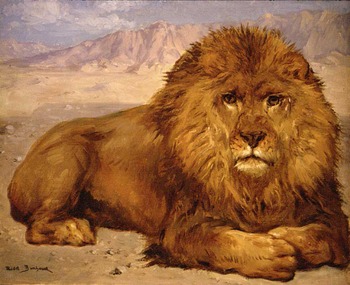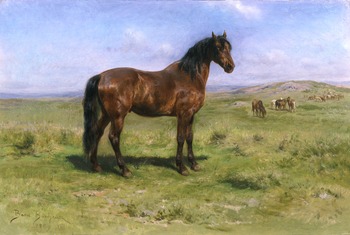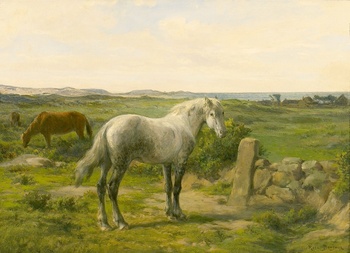Rosa Bonheur
Although she was one of the most celebrated animal painters in France during the Second Empire, Rosa Bonheur?s renown was even more widespread in Britain and America than in her own country. She made her fame on several large works executed early in her career which were exhibited internationally. Her father, Raymond Bonheur, a social radical, painted portraits and landscapes and taught drawing in Bordeaux. All five of his children became artists as well. In 1828 Raymond Bonheur moved to Paris to further his career and was followed there by his family the next year.
Rosa proved precocious and began to study with her father at an early age. She sketched in the Paris parks, copied Old Masters in the Louvre and studied animal anatomy in the Roule slaughterhouse, where she first adopted male attire for its greater convenience. After exhibiting a painting of two rabbits and one of goats and sheep at the 1841 Salon, she continued to participate in the Salons throughout the decade, winning many medals. Her Ploughing in the Nivernais, commissioned by the State in 1848, entered the Luxembourg Museum in 1849, the year she succeeded her father as director of the Paris Free School of Design for Young Girls. Her early travels included the Auvergne, southern France, the Pyrenees and Germany. About 1852, work commenced on The Horse Fair (Metropolitan Museum), which was shown at the 1853 Salon, when the artist was awarded membership to the Société des Artistes Français, which granted her exemption from the judging at all future Salons. This enormous painting of rearing and thrashing horses at the Paris Horse Market, which remained unsurpassed in her work for grandeur of composition and directness of observation, was eventually purchased by Ernest Gambart, who featured it in the 1855 French Exhibition in his Pall Mall Gallery in London. The following year Gambart conducted Rosa Bonheur on a triumphal tour of England and Scotland, during which she was befriended by Queen Victoria and met Sir E. H. Landseer, whose pictures of animals she had previously known only through engravings.
After exhibiting in 1855 Haymaking in the Auvergne, acquired by the Luxembourg, she ceased almost entirely to enter works in the Salons, although she was represented in the 1867 Exposition Universelle by nine works, including Sheep by the Sea belonging to the Empress Eugenie. In 1858-59, Rosa Bonheur bought a chateau in the hamlet of By, near Fontainebleau, which provided her with adequate space for the large menagerie of animals that she used as models. There she remained with her constant companion, the still life painter Nathalie Micas, producing her animal subjects, many of which were sold abroad through her dealer Gambart. Late in her career she turned to American western subjects, inspired by the 1889 visit to France of Colonel William F. Cody (Buffalo Bill) and his traveling show. Among her many awards was the Cross of the Legion of Honor presented to her personally in her studio by the Empress Eugenie, membership in the Antwerp Institute offered in 1868, the Leopold Cross, and the Commander?s Cross of the Royal Order of Isabella the Catholic, both presented in 1880, and elevation in 1894 to the rank of Officer of the Legion on Honor.
Selected Museum Collections:
Bordeaux, Musée des Beaux-Arts; Buffalo, NY, Albright-Knox Art Gallery; Chantilly, Musée Condé; Cleveland Museum of Art; Copenhagen, Statens Museum for Kunst, Ny Carlsberg Glyptotek; Detroit Institute of Arts; Evreux, Musée de l?Ancien Evêché; Fontainebleua, Musée national du château; Hanover, NH, Hood Museum; Lille, Palais des Beaux-Arts; London, Wallace Collection, National Gallery; Minneapolis Institute of Arts; Montauban, Musée Ingres; New York, Metropolitan Museum, Dahesh Museum; Paris, Musée d?Orsay, Louvre; Philadelphia Museum of Art; Fine Arts Museums of San Francisco; Sarasota, FL, Ringling Museum; Stockton, CA, Haggin Museum; Vernon, Musée Alphonse-Georges Poulain; Washington, D.C., National Museum of Women in the Arts;





